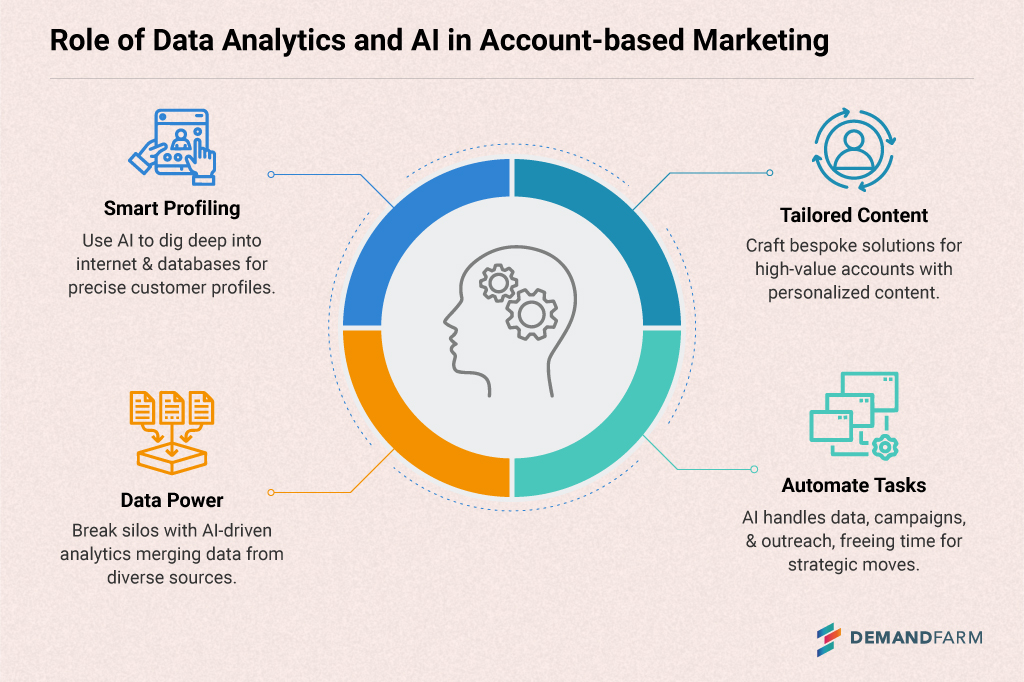The B2B landscape is undergoing a dynamic transformation, propelled by the forces of digitization, technological breakthroughs, and evolving workstyles. This multifaceted shift is reshaping the business landscape, fostering unprecedented growth and diversification. Account-based marketing or ABM is one such strategy that is aligned with account-based sales to target high-value accounts with personalized and targeted campaigns. The thought behind account-based marketing is to shift focus from volume-based lead generation programs to high-value and key accounts that are treated as individual markets.
The guiding principles of ABM are the development of relationship strategies, account-specific messaging, and complete alignment between marketing and sales. ABM’s targeted activities go beyond the traditional practices of generic marketing and result in relationship acceleration where your team focuses on engaging and delighting high-value accounts. Groundbreaking technology such as Artificial Intelligence (AI) and Data Analytics are proving to be vital tools to implement ABM even as multichannel and omnichannel strategies are providing a more seamless customer experience.
Importance of personalized and targeted marketing strategies
The cornerstone of ABM is a customized approach that uses personalized and targeted marketing strategies to create a seamless marketing experience. Data is collected from different sources and analyzed to identify patterns to effectively target best-fit, high-value accounts. These data insights also help marketers to clearly understand the specific requirements of their target accounts and nurture relationships with better engagement. Through a personalized and targeted approach, ABM aligns your solutions to the account’s business needs and creates competitive positioning.
Personalized marketing strategies have the potential to shift a targeted account from disinterest to engagement and awareness of your solutions. Targeted campaigns can also help you differentiate your offerings and position your company as the preferred provider of solutions for your high-value accounts.
“In the current digital landscape, we are overwhelmed with information and advertising. Account-based marketing narrows it down to a level at which we get customized messages that specifically address our needs as professionals, the roles that we play, and the personas we have.” – Tejas Arur, Business Communication & Customer Engagement Strategist, Axtria Inc (Snippets from episode #10 of the Shift podcast)
Tune in to the episode 10 of the Shift podcast, Dr. Karthik Nagendra, CMO at Demand Farm, interviews Tejas Arur, Business Communication & Customer Engagement Strategist at Axtria Inc., about the key principles and strategies behind account-based marketing in a digital age.
Personalized and targeted marketing strategies also help contextualize your message to the state of the account and this proves to be far more effective than the ‘spray and pray’ approach.

Role of Data Analytics and AI in Account-based Marketing
AI and data analytics are transforming ABM by boosting personalization and creating meaningful communication. AI-enabled systems that align with your account’s needs also provide transparency which is crucial for the successful implementation of your strategies. Let’s look at how AI and data analytics are optimizing account-based marketing:
1. Account Profiling
Profiling and defining customers is the starting point of any ABM program. The power of AI helps you deep dive into the internet and multiple databases to extract information for accurate customer profiling. This helps in the efficient allocation of your key resources to nurture key accounts and build lasting and fruitful relationships.
2. Creating Personalized Content
Understanding your accounts and their specific needs and pain points can help you customize your offerings and provide bespoke solutions. With clear account profiles, ABM can customize content that appeals to your high-value accounts. AI can also help you segment data mined from CRM and marketing automation platforms to create hyper-individualized experiences.
3. Automating repetitive tasks
ABM includes certain tasks like data management, campaign monitoring, and customer outreach that are significant but repetitive and tedious. You can leverage AI tools to automate these repetitive tasks and create more bandwidth for your team to focus on more strategic tasks to improve the overall campaign performance. Additionally, data management consulting can help ensure that your data processes are optimized, allowing for better decision-making and more effective use of AI tools in your ABM strategy.
4. Data Analytics & Reporting
Data is the new currency and everywhere we go, we create data points that can be used by ABM to create bespoke experiences that suit the account’s needs specifically. AI-enabled tools help you demolish data silos by merging data from disparate sources.
“Data analytics help us analyze behavior as well as segment and micro-segment and personalize content. Engagement analytics help us perform AB testing to know what kind of messaging to have, the value proposition, and product and services that we need to position,” – Tejas Arur, Business Communication & Customer Engagement Strategist, Axtria Inc (Snippets from episode #10 of the Shift podcast)
AI also adds a new dimension to ABM by elevating simple reporting and descriptive analytics to predictive analytics. This helps you to tweak your recommendations in real-time and ensure your audience is not hassled by irrelevant offers.
Synchronization between Account-based Marketing and Account-based Selling
A comprehensive approach to ABM is built on the basis of complete synergy between marketing and sales. To ensure an engaging and personalized experience for your key accounts, you have to ensure that marketing and sales are on the same page. ABM can be successfully implemented only when roles and responsibilities are clearly assigned to the sales and marketing teams. They must work together on allocating resources for each account and ensuring that there’s a smooth transition between marketing and sales activities.
The success of your account-based selling strategy largely depends on recognizing marketing as a part of the revenue team. Marketing can create customized marketing plans to create targeted campaigns for your high-value accounts. Both marketing and sales must work together at every step including reviewing the account plan and building successful campaigns.
“Sales teams and marketing assets are means to create an experience for the customer. Marketing and sales are not opposites; sales bring in outcomes that lead to instant gratification. Marketing takes longer, it’s more empirical and the messaging creates a brand, a personality, and an image for the organization. There needs to be complete sync between the two.”- Tejas Arur, Business Communication & Customer Engagement Strategist, Axtria Inc (Snippets from episode #10 of the Shift podcast)
Create a seamless customer experience through multichannel and omnichannel strategies
According to a study by PwC, 86% of B2B buyers would pay more for a ‘great customer experience’. Multichannel and omnichannel strategies create a congruence between sales and marketing in ABM leading to this seamless customer experience. Even as both strategies use multiple channels to engage the customer, the depth of integration of these channels sets them apart. While multichannel ABM focuses on buyer engagement through different channels, omnichannel ABM removes boundaries between disparate channels to create a unified customer experience. Multichannel casts a wider net and employs a tactical approach through multiple channels. In the case of omnichannel, the approach is more strategic where all communication across different channels is planned and executed in one voice.
Omnichannel in ABM includes the integration of your CRM platform, marketing automation, multi-channel digital advertising, visitor intelligence, content and website personalization as well as sales enablement. It treats the entire sales funnel as an opportunity to attract, engage, and convert the audience. Multichannel and omnichannel strategies must work together to ensure continuity in the entire sales journey by conveying the right message to the right person at the correct stage of the funnel.
Future Trends in Data-driven ABM
Account-based marketing is maturing and evolving by refining its processes to create more value for key clients. With the help of AI and data analytical tools, ABM is sharper, faster, and more efficient than ever before.
However, measurement of ABMs and quantifying ABM program results remain a challenge. Clear goals need to be set and KPIs need to be defined to accurately measure the results of your initiatives.
A study by Gartner states that B2B buyers spend only 17% of their time meeting potential suppliers in person. This clearly indicates that ABM is swiftly moving online and your digital strategies have to be razor sharp in order to engage with customers. In the coming years, aligning sales and marketing with ABM goals will be critical. The key to greater ROI and higher customer retention is a unified ABM strategy that leverages technology and omnichannel strategies to create a unique and memorable customer experience.
For more insights on ABM in the Digital Era, listen to our recent podcast https://www.demandfarm.com/podcasts/the-shift-podcast-on-digital-key-account-management-tejas-arur-axtria/

